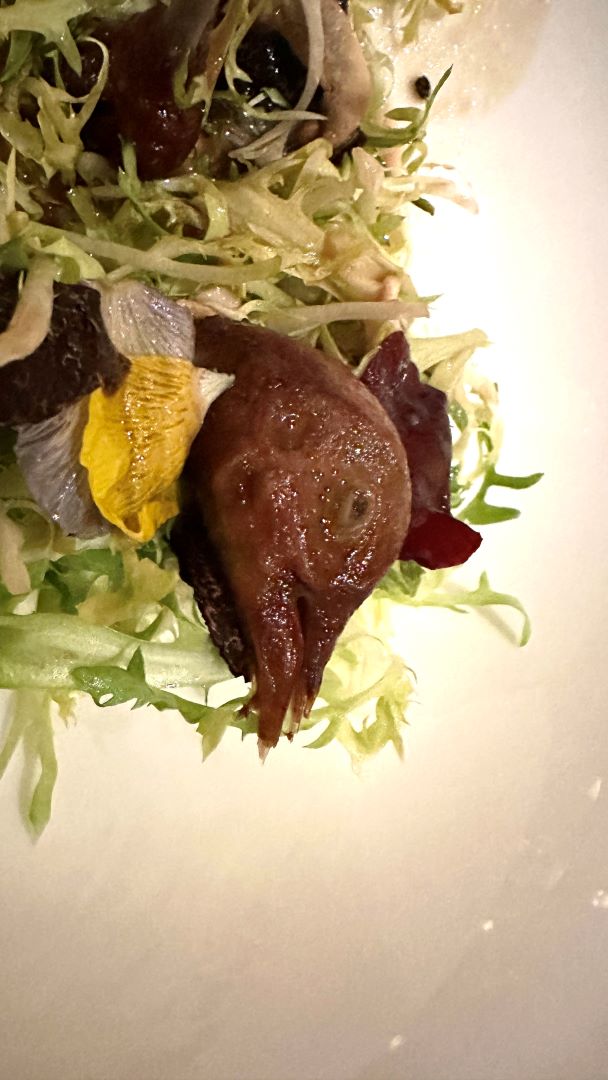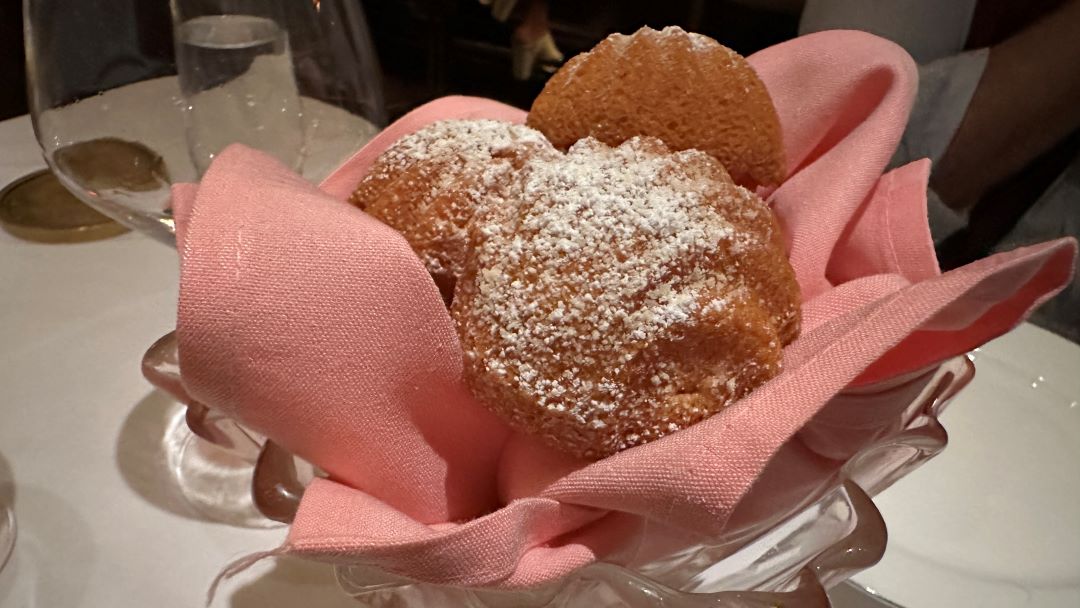Browse using the new Vinous website now. Launch →
Printed by, and for the sole use of . All rights reserved © 2015 Vinous Media
283 W 12th St
New York
NY 10014
United States
BY NEAL MARTIN | APRIL 4, 2025
The Food:
Oysters Viennese and terrine à la maison
Ravioli de cervelle de veau
Pot au feu of foie gras
Truffled pigeonneau Two Ways
"The Pig's Trotter"
Fromage
Pistachio soufflé, chocolate mint sorbet and madeleines
The Wine:
NV Ulysse Collin Extra-Brut Blanc de Blancs Les Roises (2013 base) - 95
2005 Domaine François Raveneau Chablis Butteaux 1er Cru - 90
2000 Domaine Georges Roumier Chambolle-Musigny Village - 92
2008 Domaine Mugneret-Gibourg Nuits Saint-Georges Les Chaignots 1er Cru - 91
The plan was to seek out New York’s cutting-edge cuisine. Whether it was Keens Steakhouse or Henry’s End, established in 1885 and 1973 respectively, these institutions were not going to expand gastronomic horizons, nor should they. Both are great just as they are. My final night in the Big Apple led me to another restaurant unashamedly inspired by the past, the menu a stellar cast of classic French dishes in all their indulgent glory. Le B. does it with chutzpah, flair and class.
On a bitterly cold Saturday night, I walk to the West Village, where Le B. occupies the space where The Beatrice Inn resided until 2020. Stepping inside, I notice the dark navy walls and a chichi cocktail bar on my left-hand side, an extravagant crystal chandelier dangling above, possibly nicked from the “Overlook Hotel” in the twenties. A clever use of light makes the interior feel intimate and highlights the dazzling white tablecloths. I haven’t sat down yet, but I’m already getting retro vibes. I am greeted by Restaurateur and Chef Angie Mar, a Seattle-born Chinese-American and fully paid-up Francophile. Having started her career in real estate, Mar enrolled at the French Culinary Institute, later working in and then buying The Beatrice Inn. Given the nod in the name, I ask her whether there is much overlap between The Beatrice Inn and Le B.
Chef Angie Mar in the kitchen with her brigade.
“Le B. is completely different but still tips its hat to my first restaurant, The Beatrice Inn, which was such a beloved place by so many,” Mar tells me via e-mail. “The Beatrice was focused as a chophouse, as that was its history, but with Le B., I got a fresh start. The cuisine here is what the cuisine at The Beatrice would have eventually evolved to, had I kept it open. The idea of the menu at Le B. is continental cuisine for the modern diner. Naturally, for me, that is a basis in French cuisine as that is how I am trained, but I focus on merging flavors and ingredients from my culture and upbringing and treating them in a very French way. I had an international childhood (London, Hong Kong, Seattle, New York), so all of these flavors and sensibilities are on full display on our menu. Le B. is continental and fun but very serious on technique.”
I ask which chefs inspired her, apart from the obvious one. “Chef Pierre Koffman, yes, of course!” she replies. “I think that we are so lucky to stand on these great chefs’ shoulders. The late Andre Soltner was a dear friend and a mentor—I always found his food and his spirit to be so inspiring. Marco Pierre White… I am also a bit ‘rock and roll’ at heart, so I see a kindred spirit in his cuisine. Mainly, I find inspiration in French cuisine from the fifties to the eighties: Point, Chapel, Lenôtre, Meneau. We have a very large collection of books from France during that time period in our kitchen library, and it's incredible to flip through and translate and learn.”
The Meal
The meal begins with oysters Viennese that are light and creamy, sweetened with Auslese Grande Cuvée No. 5 from Austria’s finest sweet winemaker, Alois Kracher. “I love Sauternes and oysters,” Mar tells me. “I could make an entire meal out of it, honestly. The name ‘Oysters Viennese’ is a nod and wink to Kracher, who I had the pleasure of hosting for a luncheon a few months ago. He joked that my Austrian crepes were so good, they may grant me citizenship.” The dish is an interesting combination of bivalve and vino, and the balance is just right.
Oysters Viennese.
The oyster is accompanied by terrine à la Maison made from pork and duck, with pistachio and kumquat confit. This is delicious, quite rich but not excessive, the pistachio lending a light bitterness to counter the sweetness of the terrine.
Ravioli de cervelle de veau.
The ravioli de cervelle de veau, or calf’s brain, is gorgeous. It comes with mirepoix, Osetra caviar and sauce du Japon. Quite subtle in flavour, it has a melt-in-your-mouth consistency, the ravioli itself perfectly cooked, with the caviar imparting a light saltiness.
Pot au feu of foie gras.
The pot au feu of foie gras is beautifully presented with shavings of black truffle, shiso leaf and edible flowers in a wild mushroom consommé. Again, the foie gras is decadent but not too rich, and the shiso gives it a subtle pepperiness that lingers.
Truffled pigeonneau "two-ways."
The truffled pigeonneau “two-ways” is served on the plate with black truffle, beluga lentils and mirepoix. Mar explained how the dish is prepared: “The bird is deboned and the breast meat stuffed with truffle and rolled into a ballotine, then cooked to a blush medium. The legs and the head are roasted and plated hot with a truffle and mushroom salad. Both dishes are then finished with sauce albuféra. I love a dish that has contrast, not just in flavor, but also temperature.”
Pink and tender, the pigeonnau is so tempting that I take a bite before I realise I haven't taken a photo, so I apologise for the dish looking a bit disheveled. The “other way” is a small bird that is eaten whole, including the head. Not for vegans, admittedly, but it is flavoursome with a welcome touch of bitterness.

"The Pig's Trotter" is an iconic dish, and Le B.'s rendition is superb.
The highlight of the meal is "The Pig's Trotter," obviously inspired by its creator, chef Pierre Koffman. I virtually lived on this dish about 25 years ago when I regularly dined at Mirabelle or The Square in Mayfair—arguably, the defining dish of the nineties.
“The trotter is rather classic, and for me, a labor of love,” Mar explains. “The trotters are deboned and braised with mirepoix and wine, then stuffed with a mousseline of hen and roasted veal sweetbreads and morels. We finish it by glazing it in the oven with its braising liquid and a bit of port.”
Presented whole to the table, the trotter is sliced and presented with a creamy potato. As soon as I put it into my mouth, I remember why I used to order this almost every dinner. It is perfectly cooked. Every morsel is tender and delicious.
An assortment of cheeses.
This is followed by a cheese plate comprised of Cambozola Black Label from Germany, Brillat-Savarin from France and Tête de Moines from Switzerland. These are all top-notch, and I write that as not the most ardent turophile.
Pistachio soufflé and madeleines.
To finish, pistachio soufflé is accompanied by chocolate mint sorbet and a bowl of madeleines. The soufflé, perhaps predictably, reminds me of Michel Roux’s signature dessert at the aforementioned La Gavroche, and it is just wonderful. Perhaps it is almost overdoing it with the madeleines, but they are warm and comforting.
Joined by my friends, Scott H. and Sabra L. (to give them ”Severance” nomenclature), founding members of New York’s “Champagne Society,” it was no surprise that the liquid accompaniment for this meal is sparkling and stupendous. The bottle of Les Roises from Ulysse Collin, based on the 2013 vintage, testifies to why this producer has such a devout following. Apple crumble, grilled hazelnut and lemon verbena emerge on the nose that has beautiful definition and real intensity. It gains volume in the glass and shimmers with delight. The palate has a soupçon of reduction on the entry that merely lends tension, effortlessly counterbalancing the power of this champagne. There is a lovely edge and nervosité on the finish that urges you back for another sip. What a brilliant sparkling start to the evening.

Of course, anyone who loves Chablis is going to look forward to a Raveneau. I have to admit that this bottle of 2005 Chablis Butteaux 1er Cru does not quite “launch.” It feels a little subdued on the nose, only gradually awakening with linden and wet wool scents. The palate is beautifully balanced with impressive weight, though it just misses the nuance and gravitas of a great Raveneau. The 2000 Chambolle-Musigny Village from Domaine Georges Roumier is quite the opposite. It transcends its status and forms yet more evidence that the millennial vintage was underestimated in the Côte d’Or. Complex on the nose, without seeing the label, I assume it might be a Les Cras, given its mineralité and tension. The palate is poised with fine tannins, still youthful for a 25-year-old Village Cru, with veins of blue fruit on its precise finish. It’s drinking perfectly now, but based on this bottle, it will easily give another 12 to 15 years of drinking pleasure. The 2008 Nuits Saint-Georges Les Chaignots 1er Cru from Domaine Mugneret-Gibourg boasts more fruit intensity than its peers, quite plush with black cherries, hints of cassis and peony. The palate is framed by pliant, saturated tannins that lend this Nuits Saint-Georges a more Vosne-like personality. It is not the most complex iteration that I have encountered, but I appreciate its velvety texture and harmony on the finish.
The service at Le B. must be mentioned because it is impeccable. Waiters are attired to the nines, so refreshing as many of London’s restaurants, even the top Michelin-starred ones, have dispensed with formal dress. Prices at Le B. are not cheap—then again, nothing seems to be in New York, the same as in London these days—but you are rewarded with a superb, lavish meal with just the right amount of decadence.
Departing Le B.'s doors, I wonder how the city’s restaurant scene is doing, so I ask Mar for her view. She replies, “New York is picking up, and we are hopeful it will continue. I think the major shift is the number of quality restaurants available. There are maybe a handful of really excellent places—vastly different from the New York that I fell in love with 20 years ago. The new crop of restaurants opening up seems to be geared toward the younger ‘Instagram’ set in lieu of quality of service and cuisine. I suppose I am a fanatic and a bit of a snob when it comes to the classics, though. You can probably see that's true in both my cuisine and my dining patterns.”
Sure can. And that’s just why I loved Le B.
© 2025, Vinous. No portion of this article may be copied, shared or redistributed without prior consent from Vinous. Doing so is not only a violation of our copyright but also threatens the survival of independent wine criticism.









